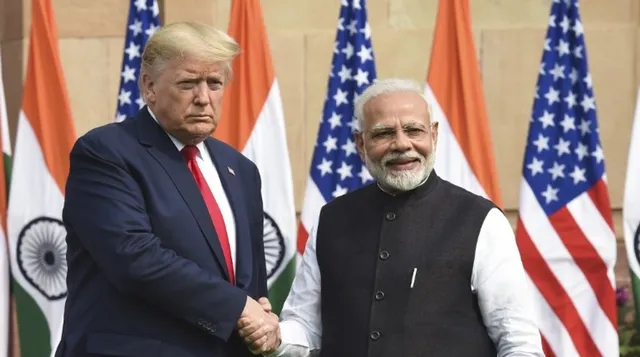By Samra Hamid
The Indo-US strategic partnership has significantly evolved, marked by recent developments that underscore its depth and implications for South Asia’s geopolitical landscape. This alliance, rooted in shared democratic values and mutual strategic interests, particularly in countering China’s expanding influence, presents both opportunities and challenges for the region.

In October 2024, India formalized an agreement with the United States to procure 31 MQ-9B drones, comprising 16 Sky Guardian and 15 Sea Guardian variants worth $4 billion. This acquisition aims to enhance India’s intelligence, surveillance, and reconnaissance capabilities across various domains. Further solidifying defense ties, the U.S. and India have made notable progress under the Defense Industrial Cooperation Roadmap.
Since 2008, India has contracted for more than $20 billion worth of U.S.-origin defense articles. This includes a variety of military equipment such as transport and maritime aircraft, helicopters, anti-ship missiles, and howitzers. In 2016, the U.S. Congress designated India as a “Major Defense Partner,” which grants India certain defense trade and security cooperation privileges. Moreover, India is expected to spend at least $200 billion over the next decade to modernize its armed forces.
Among collaborations, co-production arrangements for jet engines, munitions, and ground mobility systems are included. Notably, a teaming agreement between Lockheed Martin and Tata Advanced Systems Limited was established to set up a Maintenance, Repair, and Overhaul (MRO) facility in India for the C-130J Super Hercules aircraft.
Additionally, the launch of the India-U.S. Defense Acceleration Ecosystem (INDUS-X) initiative has raised defense innovation collaboration between governments, businesses, and academic institutions. Additionally, among the top suppliers of arms, the US is at the third number of defense exports to India. Since 2008, about 62% of India’s defense imports (by value) have come from Russia, followed by France (11%), the US (10%), and Israel (7%).
For Pakistan, the deepening Indo-US partnership raises significant security concerns. India’s bolstered military capabilities, supported by the US technology and defense systems, could potentially alter the strategic balance in South Asia. This development challenges Pakistan’s traditional reliance on strategic balance to deter aggression.
Moreover, the US strategic tilt towards India has complicated its relationship with Pakistan, a nation that has historically been a key ally in the region. It is difficult for Islamabad to balance its alliance with China while maintaining relations with Washington, as it is challenging because of the growing US-India cooperation and with historical abuse of power by India.
The Indo-Pacific region is witnessing a dynamic interplay of geopolitical forces. The US, through the Quadrilateral Security Dialogue (Quad), a strategic partnership with India, Japan, and Australia, is actively working to counter China’s growing influence. The 2023 Quad summit in Tokyo highlighted the specific focus on the importance of maintaining a “free and open Indo-Pacific,” emphasizing a rules-based order and freedom of navigation.
In contrast, China is deepening its strategic partnerships through platforms like the Shanghai Cooperation Organization (SCO). The 2024 SCO summit in Islamabad saw leaders, including China and Russia, focus on boosting mutual trade, joint investment projects, and developing new international transport corridors, signaling China’s commitment to expanding its economic and political influence within the region.
Moreover, China has intensified its cooperation with Pakistan. The China-Pakistan Economic Corridor (CPEC), a flagship project under China’s Belt and Road Initiative (BRI), exemplifies this partnership. Recent developments include the inauguration of the New Gwadar International Airport in October 2024, a project funded mainly by China, aiming to enhance connectivity and economic growth in the region. While the Indo-US partnership’s focus on military alliances and power projection could overshadow pressing regional challenges such as poverty, climate change, and human development.
In conclusion, growing defense cooperation between the United States and India has profound implications for the South Asian region. It shifts the strategic balance in favor of India, leading to increased tensions and an arms race as Pakistan and China bolster their own military capabilities in response. This cooperation also heightens military tensions, particularly in the Indian Ocean and Himalayan regions, impacting regional stability and peace.
Economically, the partnership puts pressure on countries like Pakistan, potentially facing sanctions or restrictions from the U.S. for the perceived threats. Geopolitically, the U.S.-India alliance may serve as a counterbalance to China’s influence in the perceived Indo-Pacific, prompting competition for regional dominance. Additionally, this cooperation may strengthen security alliances, with China and Pakistan deepening their strategic partnerships, further fueling a regional arms race.
The evolving Indo-US partnership is reshaping South Asia’s geopolitical contours. Its long-term success will depend on balancing power dynamics without escalating regional tensions, fostering an environment where cooperation prevails over conflict. Overall, the U.S.-India defense collaboration significantly alters the regional dynamics, affecting strategic balance, stability, economic conditions, and geopolitical alignments in South Asia.
Author: Samra Hamid – Research Fellow at Balochistan Think Tank Network, Quetta.
(The opinions expressed in this article are solely those of the author and do not necessarily reflect the views of World Geostrategic Insights).







